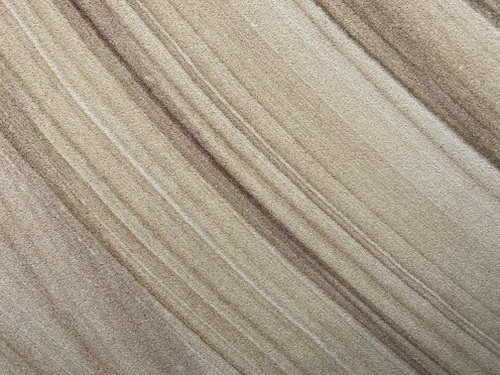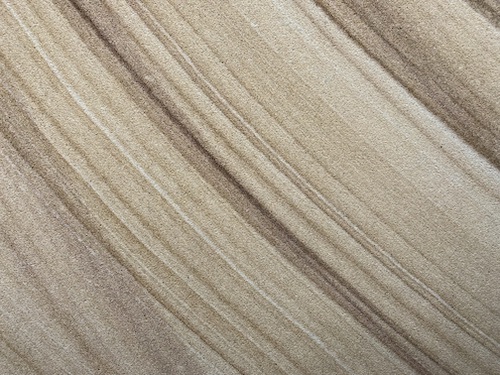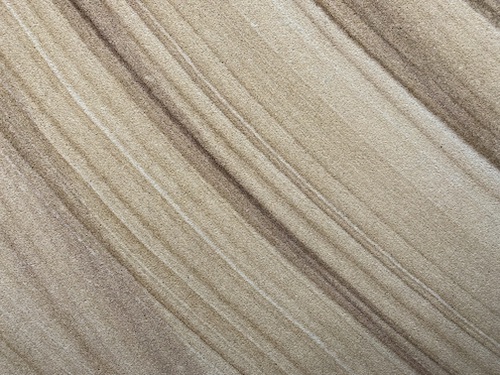Táto EarthCache ťa zavedie do centra Bratislavy. V blízkosti Grassalkovichovho paláca (Prezidentský palác) na rohu ulíc Suché mýto / Veterná nájdeš budovu s veľmi peknou pieskovcovou fasádou.
Prajem ti príjemné objavovanie!

Na mieste je možné objaviť niekoľko zaujímavých vecí.
Budova na rohu ulíc Suché mýto/Veterná má vstupnú časť s dvoma stĺpmi a pozdĺž ulíc fasádu z krájaných pieskovcových platní. Tieto fasádové platne majú krásny okrový odtieň a navyše úžasné kruhové, prstenčekové a pruhové vzory. Tieto vzory sú vytvorené tzv. Lieseganovými krúžkami, ktoré sa vyskytujú v želatinovitých tekutinách aj v horninách.
Ale najprv čo je pieskovcová hornina a ako vzniká?
Pieskovcová hornina vzniká usadením pieskových zŕn, ktoré pozostávajú väčšinou z kremene alebo iných minerálnych zložiek, ako sú živce, sľuda alebo rohovec. Tieto pieskové zrná sú transportované a usadzované prirodzenými procesmi, ako sú vietor, voda alebo ľadovce. Postupom času sa potom stmelujú a spevňujú tlakom a chemickými procesmi, ako je cementovanie hlinou, pričom vznikajú pieskovce.
Veľkosť pieskovcových zŕn sa môže líšiť v závislosti na miestnych podmienkach vzniku a druhu pieskovca. Všeobecne sa veľkosť pohybuje od 0,063 mm do 2 mm. Jemnozrnný pieskovcový kameň má menšie zrno ako hrubozrnný.
Pieskovce sú zvyčajne pórovité a môžu mať rôzne farby a štruktúry. Farba závisí od minerálnych zložiek, z ktorých pieskovce pozostávajú. Bežné farby sú béžová, žltohnedá, červenkastá alebo sivá. Povrch môže byť hladký alebo drsný v závislosti od toho, ako veľmi hornina zvetrala. Niektoré druhy pieskovca majú charakteristické štruktúry, ako je vrstvenie alebo zmena farby v dôsledku oxidov železa.
Pieskovce sa často používajú ako stavebný materiál na budovy, sochy a pamätníky vzhľadom na ich tvrdosť a odolnosť voči poveternostným podmienkam.
Čo odborník označuje ako Liesegangove kruhy a ako sa vytvárajú v pieskovci?
Liesegangove kruhy sú sústredné farebné kruhy, ktoré sa nachádzajú v pieskovcoch a iných pórovitých horninách. Vznikajú chemickou reakciou, pri ktorej sa určité minerály z horniny uvoľňujú a usádzajú sa v kruhových vzorcoch. Tieto kruhy môžu byť veľmi jemné a často sú viditeľné len pod mikroskopom.
Vznik Liesegangových kruhov v pieskovcoch je zložitý proces, ktorý závisí od mnohých faktorov. Dôležitým faktorom je pórovitá štruktúra pieskovca, ktorá umožňuje chemikáliám preniknúť do horniny a reagovať tam. Ďalším faktorom je koncentrácia reaktívnych látok, ktorá môže ovplyvniť tvorbu kruhov.
Presné mechanizmy vedúce k tvorbe krúžkov nie sú úplne pochopené, ale predpokladá sa, že vznikajú osmotickými procesmi alebo difúziou látok, ktoré musia byť prítomné v určitej koncentrácii. Keď sa tieto koncentrácie dosiahnu, vytvárajú sa kruhové vzory usadením minerálov.
Liesegangove krúžky sú zaujímavým fenoménom v geológii a majú mnoho aplikácií vo vede, napríklad pri skúmaní štruktúry a zloženia pórovitých hornín alebo pri vývoji nových materiálov.
(Raphael Eduard Liesegang, nemecký chemik a spisovateľ, objavil tento proces periodických precipitačných javov v géloch v roku 1896.)
Teraz k tvojim úlohám, aby si mohol zalogovať túto EarthCache:
-
Vlastnými slovami popíš, ako vznikajú Liesegangove kruhy v pieskovci
-
Na mieste nájdeš rôzne formy sfarbenia pieskovca. Vlastnými slovami opíš dve rôzne formy.
-
Akú farbu majú krúžky v pieskovci a ktorý minerál je za to zodpovedný?
-
Urob fotografiu seba, svojho GPS alebo iného osobného predmetu s pieskovcovou fasádou budovy v pozadí.
Pošli mi svoje odpovede pomocou správy alebo e-mailom, môžeš okamžite zalogovať. Ozvem sa ti, ak niečo nebude v poriadku.

This EarthCache takes you to the center of Bratislava. Within sight of the Grassalkovich Palace (Prezidentský palác), you will find a building with a very beautiful sandstone facade at the street corner of Suché mýto/Veterná.
I wish you a lot of enjoyment during your exploration.

What special features can be discovered on site?
The building at the corner of Suché mýto/Veterná has a facade made of cut sandstone slabs in the entrance area, behind two columns, and on the sides facing the streets. These facade slabs, in a beautiful ochre-yellow color, also have amazing circular, ring-shaped, and stripe-shaped patterns. This patterning is due to Liesegang rings, which occur in both gel-like fluids and rocks.
But first, what is sandstone and how was it formed?
Sandstone is formed by the deposition of sand grains, which are mostly composed of quartz or other mineral components such as feldspar, mica, or hornblende. These sand grains are transported and deposited by natural processes such as wind, water, or glaciers. Over time, they are then cemented and solidified by pressure and chemical processes, such as cementation with clay, forming sandstones.
The grain size of sandstone can vary depending on the environment of formation and the type of sandstone. Generally, the grain size ranges from 0.063 mm to 2 mm. Fine-grained sandstone has smaller grain sizes and coarse-grained sandstone has larger ones.
Sandstone is usually porous and can have different colors and structures. The color depends on the type of mineral components it is made of. Beige, yellowish, reddish, or gray are typical colors of sandstone. The surface can be smooth or rough, depending on how much the rock has weathered. Some types of sandstone have characteristic structures, such as layering or discoloration due to iron oxides.
Due to its hardness and weather resistance, sandstone is often used as a building material for buildings, sculptures, and monuments.
What does the expert refer to as Liesegang rings and how do they form in sandstone?
Liesegang rings are concentric colored rings found in sandstones and other porous rocks. They are formed through a chemical reaction in which certain minerals dissolve from the rock and deposit in ring-shaped patterns. These rings can be very fine and are often only visible under a microscope.
The formation of Liesegang rings in sandstone is a complex process that depends on many factors. One important factor is the porous structure of the sandstone, which allows chemicals to penetrate the rock and react there. Another factor is the concentration of reactive substances, which can influence the formation of the rings.
The exact mechanisms that lead to the formation of the rings are not yet fully understood, but it is believed that they arise through osmotic processes or through diffusion of substances that must be present in a certain concentration. When these concentrations are reached, ring-shaped patterns form through the deposition of minerals.
Liesegang rings are an interesting phenomenon in geology and have many applications in science, such as in the study of the structure and composition of porous rocks or in the development of new materials.
(Raphael Eduard Liesegang, a German chemist and writer, discovered this process of periodic precipitation phenomena in gels in 1896.)
Now to your tasks in order to be able to log this EarthCache:
-
Describe in your own words the formation of Liesegang rings in sandstone.
-
You will find different forms of discolorations in the sandstone on site. Describe two different forms in your own words.
-
What is the color tone of the rings in the sandstone and which mineral is responsible for it?
-
Take a picture of yourself, your GPS device, or another personal object with the sandstone facade of the building in the background.
Send me your answers via the messaging function or email, you may log immediately. I will contact you if something is not correct.

Dieser EarthCache führt dich in das Zentrum von Bratislava. In Sichtweite des Palais Grassalkovich (Prezidentský palác) findest du an der Straßenecke Suché mýto/Veterná ein Gebäude mit einer sehr schönen Sandsteinfassade
Ich wünsche dir bei deiner Erkundung viel Vergnügen.

Welche Besonderheiten gibt es vor Ort zu entdecken?
Das Gebäude an der Straßenecke Suché mýto/Veterná hat im Eingangsbereich, hinter den zwei Säulen und seitlich zu den Strassen eine Fassade aus geschnittenen Sandsteinplatten. Diese Fassadenplatten, im schönen ockergelben Farbton, weisen zusätzlich tolle kreis-; ring; streifenförmige Muster auf. Bei dieser Maserung handelt es sich um Liesegansche Ringe, die sowohl in gelartigen Flüssigkeiten als auch in Gesteinen vorkommen.
Aber zuerst einmal, was ist Sandstein und wie ist dieser entstanden?
Sandstein entsteht durch die Ablagerung von Sandkörnern, die meist aus Quarz oder anderen mineralischen Bestandteilen wie Feldspat, Glimmer oder Hornblende bestehen. Diese Sandkörner werden durch natürliche Prozesse wie Wind, Wasser oder Gletscher transportiert und abgelagert. Im Laufe der Zeit werden sie dann durch Druck und chemische Prozesse; Zementation mit z.B. Ton; verfestigt und zu Sandsteinen geformt.
Die Körnung von Sandstein kann je nach Entstehungsumgebung und Art des Sandsteins unterschiedlich sein. Im Allgemeinen liegt die Korngröße zwischen 0,063 mm und 2 mm. Feinkörniger Sandstein hat kleinere Korngrößen und grobkörniger Sandstein größere.
Sandstein ist in der Regel porös und kann unterschiedliche Farben und Strukturen aufweisen. Die Farbe hängt von der Art der mineralischen Bestandteile ab, aus denen er besteht. Beige, gelblich, rötlich oder grau sind typische Farben von Sandstein. Die Oberfläche kann glatt oder rau sein, je nachdem wie stark das Gestein verwittert ist. Einige Sandsteinarten weisen charakteristische Strukturen auf, wie zum Beispiel Schichtungen oder Verfärbungen durch Eisenoxide.
Aufgrund seiner Härte und Witterungsbeständigkeit wird Sandstein häufig als Baumaterial für Gebäude, Skulpturen und Denkmäler verwendet.
Was bezeichnet der Fachmann als Liesegangsche Ringe und wie entstehen diese im Sandstein?
Liesegangsche Ringe sind konzentrische Farbringe, die in Sandsteinen und anderen porösen Gesteinen zu finden sind. Sie entstehen durch eine chemische Reaktion, bei der sich bestimmte Mineralien aus dem Gestein lösen und sich in ringförmigen Mustern ablagern. Diese Ringe können sehr fein sein und sind oft nur unter dem Mikroskop sichtbar.
Die Entstehung der Liesegangschen Ringe im Sandstein ist ein komplexer Prozess, der von vielen Faktoren abhängt. Ein wichtiger Faktor ist die poröse Struktur des Sandsteins, die es den Chemikalien ermöglicht, in das Gestein einzudringen und dort zu reagieren. Ein weiterer Faktor ist die Konzentration der reaktiven Substanzen, die die Bildung der Ringe beeinflussen kann.
Die genauen Mechanismen, die zur Bildung der Ringe führen, sind noch nicht vollständig verstanden, aber es wird angenommen, dass sie durch osmotische Prozesse oder durch Diffusion von Substanzen entstehen, die in einer bestimmten Konzentration vorliegen müssen. Wenn diese Konzentrationen erreicht werden, bilden sich ringförmige Muster durch die Ablagerung von Mineralien.
Die Liesegangschen Ringe sind ein interessantes Phänomen in der Geologie und haben viele Anwendungen in der Wissenschaft, zum Beispiel bei der Untersuchung der Struktur und Zusammensetzung von porösen Gesteinen oder bei der Entwicklung neuer Materialien.
(Raphael Eduard Liesegang, ein deutscher Chemiker und Schriftsteller, hat diesen Prozess der periodischen Fällungserscheinungen in Gelen 1896 entdeckt.)
Nun zu Deinen Aufgaben, um diesen EarthCache loggen zu dürfen:
1. Beschreibe mit eigenen Worten die Entstehung von Liesegangschen Ringen im Sandstein.
2. Du findest vor Ort verschiedene Formen von Verfärbungen des Sandsteines vor. Beschreibe mit eigenen Worten zwei verschiedene Formen.
3. Welchen Farbton haben die Ringe im Sandstein und welches Mineral ist dafür
4. Mache ein Bild von dir, deinem GPS oder einem anderen persönlichen Gegenstand mit der Sandsteinfassade des Gebäudes im Hintergrund.
Sende mir Deine Antworten über die Nachrichtenfunktion oder per Mail zu, Du darfst sofort loggen. Ich melde mich, wenn etwas nicht stimmt.
Zdrojová citácia / Source citation /Quellenangabe:
www.wikipedia.de
www.Spektrum.de
eigene Bilder